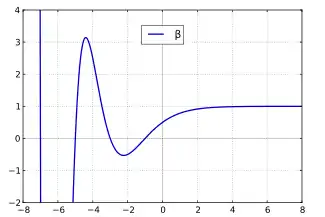
In mathematics, the Dirichlet beta function (also known as the Catalan beta function) is a special function, closely related to the Riemann zeta function. It is a particular Dirichlet L-function, the L-function for the alternating character of period four.
Definition
The Dirichlet beta function is defined as
or, equivalently,
In each case, it is assumed that Re(s) > 0.
Alternatively, the following definition, in terms of the Hurwitz zeta function, is valid in the whole complex s-plane:[1]
Another equivalent definition, in terms of the Lerch transcendent, is:
which is once again valid for all complex values of s.
The Dirichlet beta function can also be written in terms of the polylogarithm function:
Also the series representation of Dirichlet beta function can be formed in terms of the polygamma function
but this formula is only valid at positive integer values of .
Euler product formula
It is also the simplest example of a series non-directly related to which can also be factorized as an Euler product, thus leading to the idea of Dirichlet character defining the exact set of Dirichlet series having a factorization over the prime numbers.
At least for Re(s) ≥ 1:
where p≡1 mod 4 are the primes of the form 4n+1 (5,13,17,...) and p≡3 mod 4 are the primes of the form 4n+3 (3,7,11,...). This can be written compactly as
Functional equation
The functional equation extends the beta function to the left side of the complex plane Re(s) ≤ 0. It is given by
where Γ(s) is the gamma function. It was conjectured by Euler in 1749 and proved by Malmsten in 1842 (see Blagouchine, 2014).
Special values
Some special values include:
where G represents Catalan's constant, and
where in the above is an example of the polygamma function.
Hence, the function vanishes for all odd negative integral values of the argument.
For every positive integer k:
where is the Euler zigzag number.
Also it was derived by Malmsten in 1842 (see Blagouchine, 2014) that
| s | approximate value β(s) | OEIS |
|---|---|---|
| 1/5 | 0.5737108471859466493572665 | A261624 |
| 1/4 | 0.5907230564424947318659591 | A261623 |
| 1/3 | 0.6178550888488520660725389 | A261622 |
| 1/2 | 0.6676914571896091766586909 | A195103 |
| 1 | 0.7853981633974483096156608 | A003881 |
| 2 | 0.9159655941772190150546035 | A006752 |
| 3 | 0.9689461462593693804836348 | A153071 |
| 4 | 0.9889445517411053361084226 | A175572 |
| 5 | 0.9961578280770880640063194 | A175571 |
| 6 | 0.9986852222184381354416008 | A175570 |
| 7 | 0.9995545078905399094963465 | |
| 8 | 0.9998499902468296563380671 | |
| 9 | 0.9999496841872200898213589 | |
| 10 | 0.9999831640261968774055407 |
There are zeros at -1; -3; -5; -7 etc.
See also
References
- ↑ Dirichlet Beta – Hurwitz zeta relation, Engineering Mathematics
- Blagouchine, I. V. (2014). "Rediscovery of Malmsten's integrals, their evaluation by contour integration methods and some related results". Ramanujan J. 35 (1): 21–110. doi:10.1007/s11139-013-9528-5.
- Glasser, M. L. (1972). "The evaluation of lattice sums. I. Analytic procedures". J. Math. Phys. 14 (3): 409. Bibcode:1973JMP....14..409G. doi:10.1063/1.1666331.
- J. Spanier and K. B. Oldham, An Atlas of Functions, (1987) Hemisphere, New York.
- Weisstein, Eric W. "Dirichlet Beta Function". MathWorld.